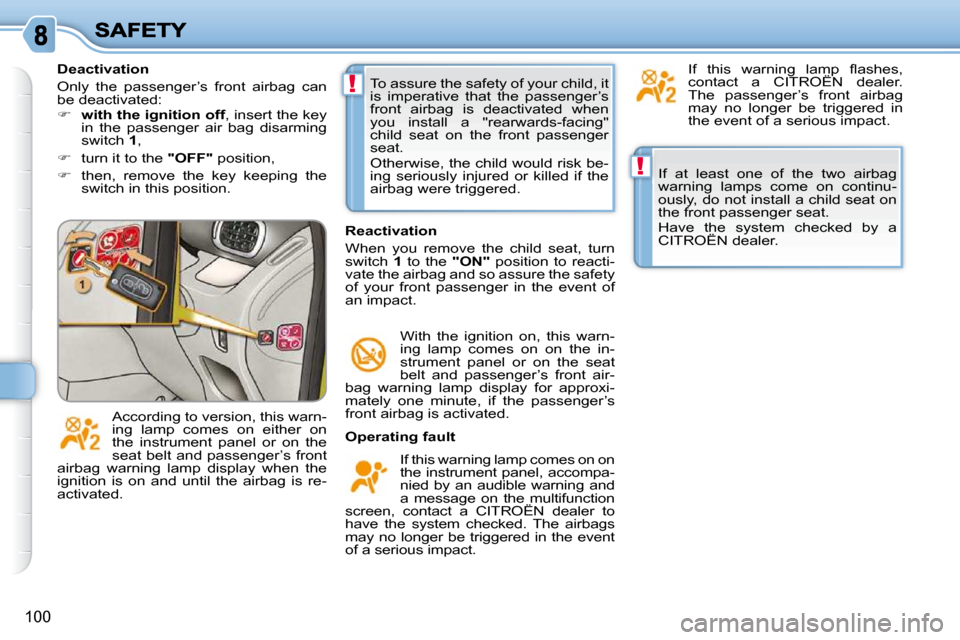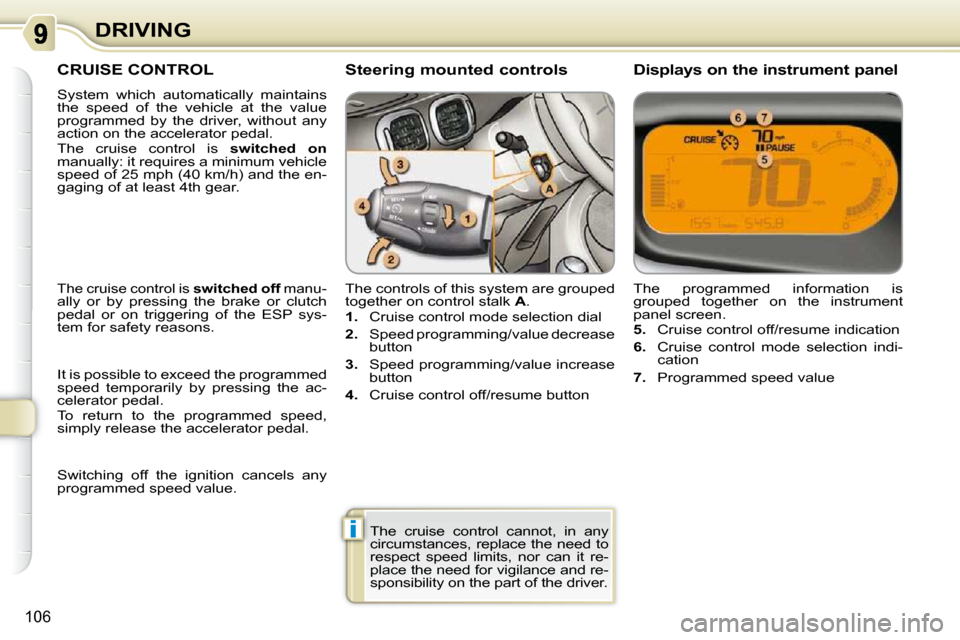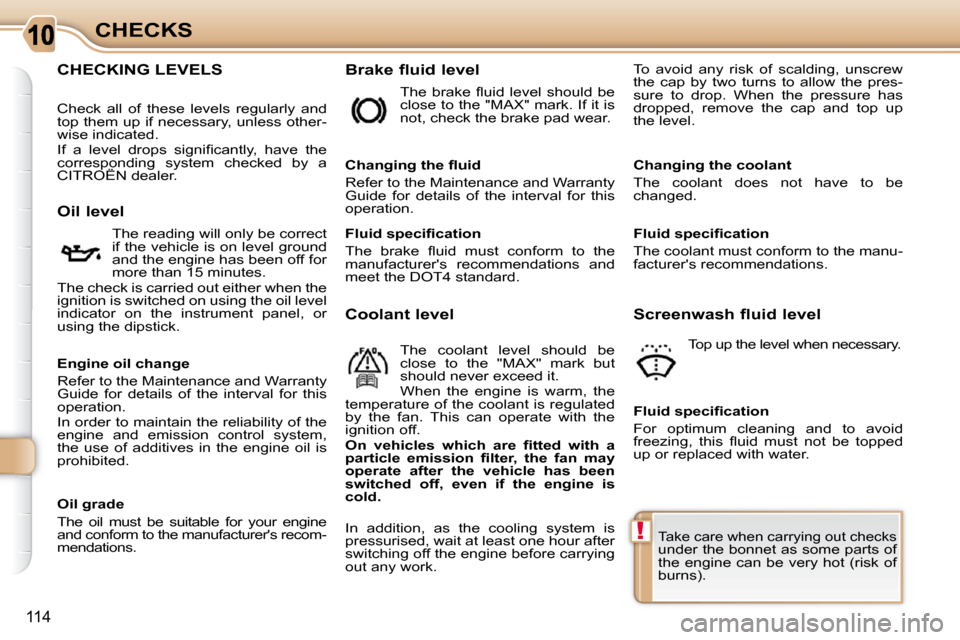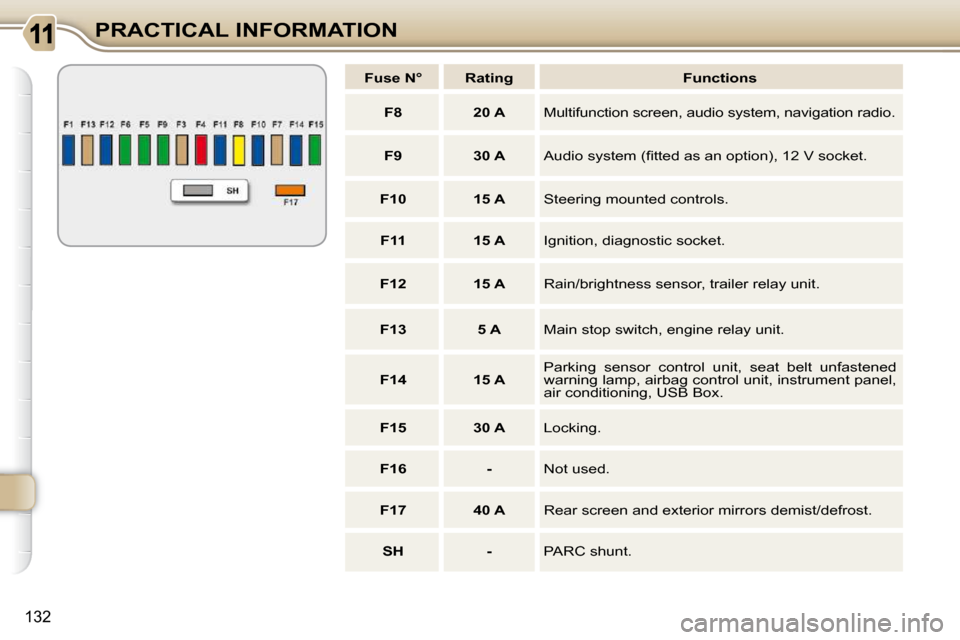ignition Citroen C3 PICASSO 2009.5 1.G Owner's Guide
[x] Cancel search | Manufacturer: CITROEN, Model Year: 2009.5, Model line: C3 PICASSO, Model: Citroen C3 PICASSO 2009.5 1.GPages: 198, PDF Size: 9.99 MB
Page 101 of 198

!
i
99
AIRBAGS
Triggering of the airbag(s) is ac-
companied by a slight emission of
harmless smoke and a noise, due
to the activation of the pyrotechnic
cartridge incorporated in the system.
This smoke is not harmful, but sen-
sitive individuals may experience
slight irritation.
The noise of the detonation may
result in a slight loss of hearing for
a short time.
Front airbags
System which protects the driver and
front passenger in the event of a seri-
ous front impact in order to limit the risk
of injury to the head and chest.
The driver’s airbag is incorporated in
the centre of the steering wheel; the
front passenger’s airbag is incorporated
in the dashboard above the glove box.
Activation
The airbags are triggered simultaneous-ly, unless the passenger’s front airbag
is deactivated, in the event of a serious
front impact applied to all or part of the
front impact zone A , in the longitudinal
centreline of the vehicle on a horizontal
plane and directed from the front to the
rear of the vehicle.
� �T�h�e� �f�r�o�n�t� �a�i�r�b�a�g� �i�n�fl� �a�t�e�s� �b�e�t�w�e�e�n� �t�h�e�
front occupant of the vehicle and the
dashboard to cushion their forward
movement.
Impact detection zones
A. Front impact zone.
B. Side impact zone.
The airbags do not operate when
the ignition is switched off.
This equipment will only deploy
once. If a second impact occurs
(during the same or a subsequent
accident), the airbag will not be
triggered again.
System designed to maximise the safety
of the occupants (with the exception of
the rear centre passenger) in the event
of violent collisions. It supplements the
action of the force-limiting seat belts
(with the exception of the rear centre
passenger).
If a collision occurs, the electronic de-
tectors record and analyse the front and
side impacts sustained in the impact
detection zones:
- in the case of a serious impact, the
airbags are triggered instantly and
protect the occupants of the vehicle
(with the exception of the rear centre
passenger); immediately after the
�i�m�p�a�c�t�,� �t�h�e� �a�i�r�b�a�g�s� �d�e�fl� �a�t�e� �r�a�p�i�d�l�y�
so that they do not hinder visibility
or the exit of the occupants,
- in the case of a minor or rear impact or in certain roll-over conditions, the
airbags will not be triggered; the
�s�e�a�t� �b�e�l�t� �a�l�o�n�e� �i�s� �s�u�f�fi� �c�i�e�n�t� �t�o� �p�r�o�-
vide optimum protection in these
situations.
Page 102 of 198

!
!
100
If at least one of the two airbag
warning lamps come on continu-
ously, do not install a child seat on
the front passenger seat.
Have the system checked by a
CITROËN dealer.
Operating fault If this warning lamp comes on on
the instrument panel, accompa-
nied by an audible warning and
a message on the multifunction
screen, contact a CITROËN dealer to
have the system checked. The airbags
may no longer be triggered in the event
of a serious impact.
Reactivation
When you remove the child seat, turn
switch
1 to the "ON" position to reacti-
vate the airbag and so assure the safety
of your front passenger in the event of
an impact.
With the ignition on, this warn-
ing lamp comes on on the in-
strument panel or on the seat
belt and passenger’s front air-
bag warning lamp display for approxi-
mately one minute, if the passenger’s
front airbag is activated. To assure the safety of your child, it
is imperative that the passenger’s
front airbag is deactivated when
you install a "rearwards-facing"
child seat on the front passenger
seat.
Otherwise, the child would risk be-
ing seriously injured or killed if the
airbag were triggered.
According to version, this warn-
ing lamp comes on either on
the instrument panel or on the
seat belt and passenger’s front
airbag warning lamp display when the
ignition is on and until the airbag is re-
activated. � �I�f� �t�h�i�s� �w�a�r�n�i�n�g� �l�a�m�p� �fl� �a�s�h�e�s�,�
contact a CITROËN dealer.
The passenger’s front airbag
may no longer be triggered in
the event of a serious impact.
Deactivation
Only the passenger’s front airbag can
be deactivated:
� with the ignition off , insert the key
in the passenger air bag disarming
switch 1 ,
� turn it to the "OFF" position,
� then, remove the key keeping the
switch in this position.
Page 107 of 198

i
104
DRIVING
SPEED LIMITER
System which prevents the vehicle from
exceeding the speed programmed by
the driver.
When the programmed speed limit is
reached, pressing the accelerator pedal in
the normal manner no longer has any effect.
The controls of this system are grouped
together on stalk A .
1. Speed limiter mode selection thumb
wheel
2. Value decrease button
3. Value increase button
4. Speed limiter on/off button The programmed information is
grouped together on the instrument
panel screen.
5. Speed limiter on/off indication
6.
Speed limiter mode selection indication
7. Programmed speed value
Steering mounted controls Displays on the instrumen
t panel
The speed limiter cannot, in any
circumstances, replace the need
to respect speed limits, nor can it
replace the need for vigilance and
responsibility on the part of the
driver.
The speed limiter is
switched on manu-
ally: it requires a programmed speed of
at least 20 mph (30 km/h).
The speed limiter is switched off by
manual operation of the control.
The programmed speed can be exceeded
temporarily by pressing the accelerator
�fi� �r�m�l�y�.�
To return to the programmed speed,
simply slow down to a speed below the
programmed speed.
The programmed speed remains in the
memory when the ignition is switched
off.
Page 109 of 198

i
106
DRIVING
CRUISE CONTROL
System which automatically maintains
the speed of the vehicle at the value
programmed by the driver, without any
action on the accelerator pedal.
The cruise control is switched on
manually: it requires a minimum vehicle
speed of 25 mph (40 km/h) and the en-
gaging of at least 4th gear.
The controls of this system are grouped
together on control stalk A .
1. Cruise control mode selection dial
2. Speed programming/value decrease
button
3. Speed programming/value increase
button
4. Cruise control off/resume button The programmed information is
grouped together on the instrument
panel screen.
5. Cruise control off/resume indication
6. Cruise control mode selection indi-
cation
7. Programmed speed value
Steering mounted controls Displays on the instrumen
t panel
The cruise control cannot, in any
circumstances, replace the need to
respect speed limits, nor can it re-
place the need for vigilance and re-
sponsibility on the part of the driver.
The cruise control is switched off manu-
ally or by pressing the brake or clutch
pedal or on triggering of the ESP sys-
tem for safety reasons.
It is possible to exceed the programmed
speed temporarily by pressing the ac-
celerator pedal.
To return to the programmed speed,
simply release the accelerator pedal.
Switching off the ignition cancels any
programmed speed value.
Page 116 of 198

!
114
CHECKS
CHECKING LEVELS Brake fluid level
Oil level The reading will only be correct
if the vehicle is on level ground
and the engine has been off for
more than 15 minutes.
The check is carried out either when the
ignition is switched on using the oil level
indicator on the instrument panel, or
using the dipstick. � �T�h�e� �b�r�a�k�e� �fl� �u�i�d� �l�e�v�e�l� �s�h�o�u�l�d� �b�e�
close to the "MAX" mark. If it is
not, check the brake pad wear.
� � �C�h�a�n�g�i�n�g� �t�h�e� �fl� �u�i�d�
Refer to the Maintenance and Warranty
Guide for details of the interval for this
operation.
Coolant level The coolant level should be
close to the "MAX" mark but
should never exceed it.
When the engine is warm, the
temperature of the coolant is regulated
by the fan. This can operate with the
ignition off.
�O�n� �v�e�h�i�c�l�e�s� �w�h�i�c�h� �a�r�e� �fi� �t�t�e�d� �w�i�t�h� �a�
�p�a�r�t�i�c�l�e� �e�m�i�s�s�i�o�n� �fi� �l�t�e�r�,� �t�h�e� �f�a�n� �m�a�y�
operate after the vehicle has been
�s�w�i�t�c�h�e�d� �o�f�f�,� �e�v�e�n� �i�f� �t�h�e� �e�n�g�i�n�e� �i�s�
cold.
In addition, as the cooling system is
pressurised, wait at least one hour after
switching off the engine before carrying
out any work. � � �F�l�u�i�d� �s�p�e�c�i�fi� �c�a�t�i�o�n�
For optimum cleaning and to avoid
�f�r�e�e�z�i�n�g�,� �t�h�i�s� �fl� �u�i�d� �m�u�s�t� �n�o�t� �b�e� �t�o�p�p�e�d�
up or replaced with water.
Engine oil change
Refer to the Maintenance and Warranty
Guide for details of the interval for this
operation.
In order to maintain the reliability of the
engine and emission control system,
the use of additives in the engine oil is
prohibited.
Oil grade
The oil must be suitable for your engine
and conform to the manufacturer's recom-
mendations. � � �F�l�u�i�d� �s�p�e�c�i�fi� �c�a�t�i�o�n�
� �T�h�e� �b�r�a�k�e� �fl� �u�i�d� �m�u�s�t� �c�o�n�f�o�r�m� �t�o� �t�h�e�
manufacturer's recommendations and
meet the DOT4 standard.
� � �F�l�u�i�d� �s�p�e�c�i�fi� �c�a�t�i�o�n�
The coolant must conform to the manu-
facturer's recommendations.
Changing the coolant
The coolant does not have to be
changed.
Screenwash fluid level
Check all of these levels regularly and
top them up if necessary, unless other-
wise indicated.
� �I�f� �a� �l�e�v�e�l� �d�r�o�p�s� �s�i�g�n�i�fi� �c�a�n�t�l�y�,� �h�a�v�e� �t�h�e�
corresponding system checked by a
CITROËN dealer.
To avoid any risk of scalding, unscrew
the cap by two turns to allow the pres-
sure to drop. When the pressure has
dropped, remove the cap and top up
the level.
Top up the level when necessary.
Take care when carrying out checks under the bonnet as some parts of
the engine can be very hot (risk of
burns).
Page 120 of 198

i
117
PRACTICAL INFORMATION
It is designed to repair most punc-
tures which could affect the tyre, lo-
cated on the tyre tread or shoulder.
Avoid removing any foreign bodies
which have penetrated the tyre.
TEMPORARY PUNCTURE REPAIR KIT
Complete system consisting of a com-
pressor and an incorporated sealant
cartridge which permits temporary re-
pair of the tyre so that you can drive to
the nearest garage. Using the kit
This procedure, comprising several
steps, must be carried out in full.
� Switch off the ignition.
�
Turn the selector A to the "SEALANT"
position.
� Check that the switch B is in posi-
tion "0" .
� Connect the white pipe C to the
valve of the tyre to be repaired.
� Connect the compressor's electric
plug to the vehicle's 12 V socket.
� � � �A�f�fi� �x� �t�h�e� �s�p�e�e�d� �l�i�m�i�t�a�t�i�o�n� �s�t�i�c�k�e�r� �t�o�
the vehicle's steering wheel to re-
mind you that a wheel is in temporary
use.
� Start the vehicle and leave the
engine running.
Access to the kit
This repair kit is available from CITROËN
dealers.
Page 135 of 198

132
PRACTICAL INFORMATION
Fuse N° Rating Functions
F8 20 A Multifunction screen, audio system, navigation radio.
F9 30 A � �A�u�d�i�o� �s�y�s�t�e�m� �(�fi� �t�t�e�d� �a�s� �a�n� �o�p�t�i�o�n�)�,� �1�2� �V� �s�o�c�k�e�t�.�
F10 15 A Steering mounted controls.
F11 15 A Ignition, diagnostic socket.
F12 15 A Rain/brightness sensor, trailer relay unit.
F13 5 A Main stop switch, engine relay unit.
F14 15 A Parking sensor control unit, seat belt unfastened
warning lamp, airbag control unit, instrument panel,
�a�i�r� �c�o�n�d�i�t�i�o�n�i�n�g�,� �U�S�B� �B�o�x�.�
F15 30 A Locking.
F16 - Not used.
F17 40 A � �R�e�a�r� �s�c�r�e�e�n� �a�n�d� �e�x�t�e�r�i�o�r� �m�i�r�r�o�r�s� �d�e�m�i�s�t�/�d�e�f�r�o�s�t�.�
SH - PARC shunt.
Page 140 of 198

i
!
137
PRACTICAL INFORMATION
Do not disconnect the terminals
while the engine is running.
Do not charge the batteries without
�d�i�s�c�o�n�n�e�c�t�i�n�g� �t�h�e� �t�e�r�m�i�n�a�l�s� �fi� �r�s�t�.�
Batteries contain harmful sub-
stances such as sulphuric acid and
lead. They must be disposed of in
accordance with regulations and
must not, in any circumstances, be
discarded with household waste.
Take used remote control batteries
and vehicle batteries to a special
collection point.
Charging the battery using a
battery charger
� Disconnect the battery from the
vehicle.
� Follow the instructions for use
provided by the manufacturer of the
charger.
� Reconnect starting with the nega-
�t�i�v�e� �t�e�r�m�i�n�a�l� �(�-�)�.�
�
Check that the terminals and connec-
tors are clean. If they are covered with
�s�u�l�p�h�a�t�e� �(�w�h�i�t�i�s�h� �o�r� �g�r�e�e�n�i�s�h� �d�e�p�o�s�i�t�)�,�
remove them and clean them.
LOAD REDUCTION MODE
System which manages the use of
certain functions according to the level
of charge remaining in the battery.
When the vehicle is being driven, the
load reduction function temporarily de-
activates certain functions, such as
the air conditioning, the heated rear
screen...
The deactivated functions are reactivat-
ed automatically as soon as conditions
permit.
It is advisable to disconnect the
battery if the vehicle is to be left
unused for more than one month. Before disconnecting the
battery
Wait 2 minutes after switching off
the ignition before disconnecting
the battery.
Close the windows and the doors
before disconnecting the battery.
Following reconnection of the
battery
Following reconnection of the bat-
tery, switch on the ignition and wait
1 minute before starting to permit
initialisation of the electronic sys-
tems. However, if minor problems
persist following this operation,
contact a CITROËN dealer.
Referring to the corresponding
section, you should yourself reini-
�t�i�a�l�i�s�e�:�
- the remote control key,
- the GPS satellite navigation
system.
Page 141 of 198

i
!
137
PRACTICAL INFORMATION
Do not disconnect the terminals
while the engine is running.
Do not charge the batteries without
�d�i�s�c�o�n�n�e�c�t�i�n�g� �t�h�e� �t�e�r�m�i�n�a�l�s� �fi� �r�s�t�.�
Batteries contain harmful sub-
stances such as sulphuric acid and
lead. They must be disposed of in
accordance with regulations and
must not, in any circumstances, be
discarded with household waste.
Take used remote control batteries
and vehicle batteries to a special
collection point.
Charging the battery using a
battery charger
� Disconnect the battery from the
vehicle.
� Follow the instructions for use
provided by the manufacturer of the
charger.
� Reconnect starting with the nega-
�t�i�v�e� �t�e�r�m�i�n�a�l� �(�-�)�.�
�
Check that the terminals and connec-
tors are clean. If they are covered with
�s�u�l�p�h�a�t�e� �(�w�h�i�t�i�s�h� �o�r� �g�r�e�e�n�i�s�h� �d�e�p�o�s�i�t�)�,�
remove them and clean them.
LOAD REDUCTION MODE
System which manages the use of
certain functions according to the level
of charge remaining in the battery.
When the vehicle is being driven, the
load reduction function temporarily de-
activates certain functions, such as
the air conditioning, the heated rear
screen...
The deactivated functions are reactivat-
ed automatically as soon as conditions
permit.
It is advisable to disconnect the
battery if the vehicle is to be left
unused for more than one month. Before disconnecting the
battery
Wait 2 minutes after switching off
the ignition before disconnecting
the battery.
Close the windows and the doors
before disconnecting the battery.
Following reconnection of the
battery
Following reconnection of the bat-
tery, switch on the ignition and wait
1 minute before starting to permit
initialisation of the electronic sys-
tems. However, if minor problems
persist following this operation,
contact a CITROËN dealer.
Referring to the corresponding
section, you should yourself reini-
�t�i�a�l�i�s�e�:�
- the remote control key,
- the GPS satellite navigation
system.
Page 142 of 198

i
!
138
PRACTICAL INFORMATION� �A� �fl� �a�t� �b�a�t�t�e�r�y� �p�r�e�v�e�n�t�s� �t�h�e� �e�n�g�i�n�e�
from starting (refer to the corre-
�s�p�o�n�d�i�n�g� �p�a�r�a�g�r�a�p�h�)�.� �
If the telephone is being used at
the same time on the MyWay audio
navigation system, it will be inter-
rupted after 10 minutes.
ENERGY ECONOMY MODE
System which manages the period of
use of certain functions to conserve a
�s�u�f�fi� �c�i�e�n�t� �l�e�v�e�l� �o�f� �c�h�a�r�g�e� �i�n� �t�h�e� �b�a�t�t�e�r�y�.�
After the engine has stopped, you can
still use functions such as the audio
�e�q�u�i�p�m�e�n�t�,� �w�i�n�d�s�c�r�e�e�n� �w�i�p�e�r�s�,� �d�i�p�p�e�d�
beam headlamps, courtesy lamps, etc.
�f�o�r� �a� �m�a�x�i�m�u�m� �c�o�m�b�i�n�e�d� �p�e�r�i�o�d� �o�f�
thirty minutes.
This period may be greatly reduced if
the battery is not fully charged. Exiting economy mode
These functions are reactivated auto-
�m�a�t�i�c�a�l�l�y� �t�h�e� �n�e�x�t� �t�i�m�e� �t�h�e� �v�e�h�i�c�l�e� �i�s�
driven.
� In order to resume the use of these
functions immediately, start the en-
gine and let it run for a few minutes.
The time available to you will then be dou-
ble the period for which the engine is left
running. However, this period will always
�b�e� �b�e�t�w�e�e�n� �fi� �v�e� �a�n�d� �t�h�i�r�t�y� �m�i�n�u�t�e�s�.�
Switching to economy mode
Once this period has elapsed, a mes-
sage appears on the multifunction
screen indicating that the vehicle has
switched to economy mode and the
active functions are put on standby.
CHANGING A FRONT OR REAR WIPER BLADE
Procedure for replacing a worn wiper
blade with a new one without the use
of tools.
Removal
� Raise the corresponding wiper arm.
� Unclip the wiper blade and remove it.
Fitting
� At the front, check the size of the wiper
�b�l�a�d�e� �a�s� �t�h�e� �s�h�o�r�t�e�r� �b�l�a�d�e� �i�s� �fi� �t�t�e�d� �t�o�
the passenger side of the vehicle.
� Put the corresponding new wiper
blade in place and clip it.
� Fold down the wiper arm carefully.
Before removing a front wiper
blade
� Within one minute after switching off
the ignition, operate the wiper stalk
to position the wiper blades in the
vertical position.
This position must be used in order to avoid
damaging the wiper blade and the bonnet.
After fitting a front wiper blade
� Switch on the ignition.
� Operate the wiper stalk again to
park the wiper blades.